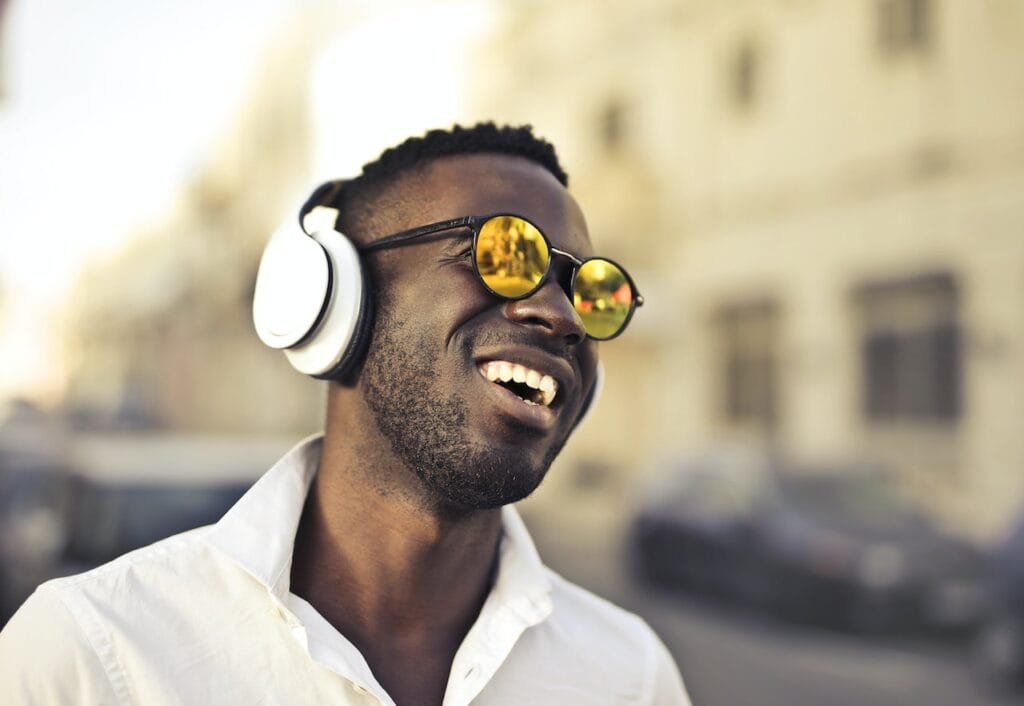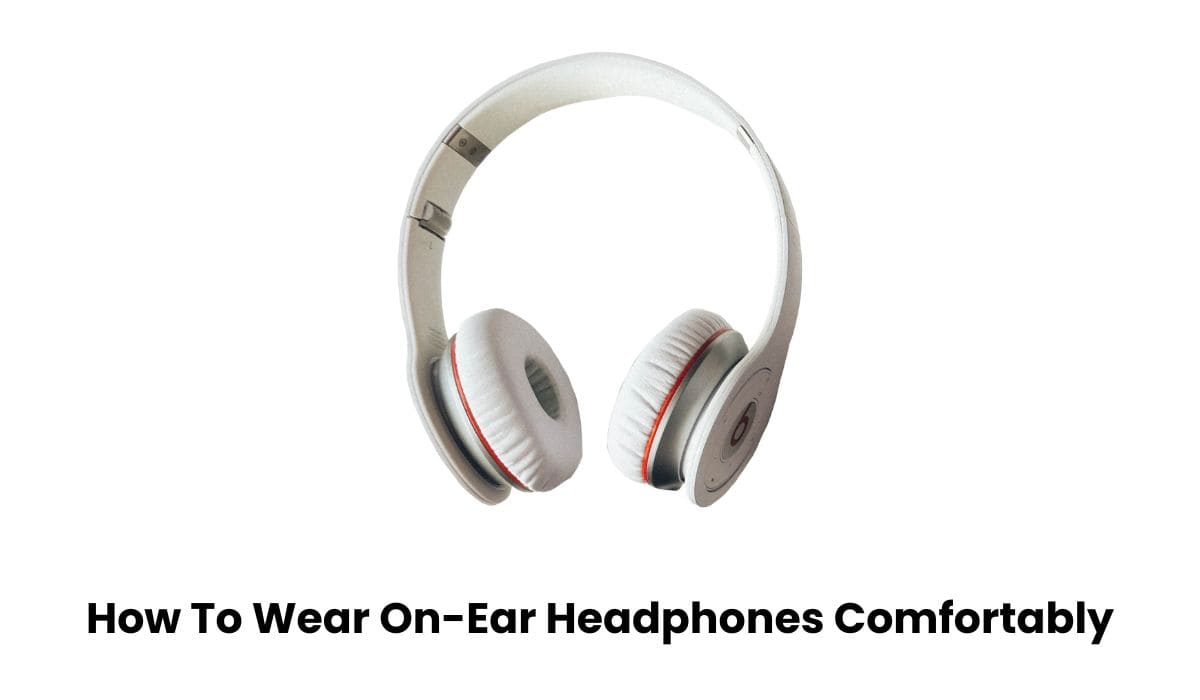If you’re an avid music listener or a professional who needs to work with audio, you know the importance of comfortable headphones. While over-ear headphones can sometimes feel too bulky, you might need more than in-ear headphones to provide the sound quality you need. That’s where on-ear headphones come in, as they balance comfort and quality.
However, finding the perfect on-ear headphones can be tricky, and even if you have found a pair you like, you might still experience discomfort after a while.
In this guide, we will provide tips and tricks on how to wear on-ear headphones comfortably, so you can enjoy your music or work without any distractions.
Table of Contents
Understanding On-Ear Headphones:

Before we dive into the specifics of wearing on-ear headphones, let’s first understand what they are. On-ear headphones are designed to sit on the ears rather than enclosing them completely like over-ear headphones.
They are usually lighter and more portable than over-ear headphones while providing decent sound quality. On-ear headphones come in different designs, such as closed-back or open-back, wired or wireless, with varying features like noise-canceling or in-line controls.
Why Is It Important To Wear On-Ear Headphones Correctly?

Wearing on-ear headphones correctly is crucial for several reasons. First and foremost, proper headphones usage ensures you get the best possible sound quality. When you wear headphones incorrectly, you may experience discomfort or pain, distracting you from the music or audio you are listening to. Additionally, wearing headphones improperly can result in sound leakage, where the music or audio can be heard by others nearby. This can be annoying and intrusive to those around you, especially in quiet places such as libraries or public transport.
Correctly wearing on-ear headphones also protects your hearing by limiting the volume level to safe levels. Finally, wearing headphones correctly also ensures their longevity and durability. Taking care of your headphones can extend their lifespan and save money in the long run.
In conclusion, wearing on-ear headphones correctly is essential for your headphone’s comfort, sound quality, hearing protection, and longevity.
How To Wear On-Ear Headphones Comfortably (10 Tips):

On-ear headphones are famous for music lovers who prefer a more compact, lightweight design than over-ear headphones. But wearing on-ear headphones for long periods can be uncomfortable, and it may lead to pain and pressure on the ears. Below are ten tips that help you wear on-ear headphones comfortably.
1. Choose the Right Headphones
Choosing the right headphones is the first step to ensuring comfort while wearing on-ear headphones. Look for headphones with a comfortable headband and ear cups that fit snugly on your ears. The headband should be adjustable to fit your head size, and the ear cups should be cushioned with soft material.
2. Adjust the Headband
Adjusting the headband is crucial for a comfortable fit. It would help to change the headband to fit snugly on your head without being too tight. If the headband is too tight, it may cause discomfort and pain over time. If the headband is close enough, it may provide enough support, and the headphones may slide around.
3. Position the Ear Cups
Positioning the ear cups is also essential for comfort. Set the ear cups to comfortably on your ears without pressing down too hard. If the ear cups are pressed down too hard, it may cause pain and discomfort. You may only get the best sound quality if the ear cups are positioned correctly.
4. Take Breaks
Taking breaks is essential when wearing on-ear headphones for an extended period. Taking a break every hour or so can help alleviate pressure and ear pain. You should also remove the headphones for a few minutes to give your ears a break.
5. Wear Them Properly
Wearing on-ear headphones properly is crucial for comfort. It would help if you placed the headband over your head and then positioned the ear cups over your ears. You should also ensure the ear cups are not twisted or turned in.
6. Use Headphone Covers
Using headphone covers can help improve comfort and hygiene. Headphone covers are small disposable covers that fit over the ear cups and protect them from sweat and dirt. They can also help prevent the spread of bacteria and germs.
7. Use Ear Pads
Using ear pads can help improve comfort when wearing on-ear headphones. Ear pads are small cushioned pads that fit over the ear cups and provide additional padding. They can help reduce pressure and pain in your ears.
8. Keep Your Headphones Clean
Keeping your headphones clean can help prevent dirt and debris from building up, which can cause discomfort and irritation. It would help if you regularly wiped down the ear cups and headbands with a soft cloth to keep them clean.
9. Use Noise Cancelling Feature
Many on-ear headphones come with a noise-canceling feature that blocks out external noise. Using this feature can help reduce the need to turn up the volume, which can lead to discomfort and potential hearing damage.
10. Use a Headphone Stand
Using a headphone stand can help keep your headphones organized and prevent damage. A headphone stand can also help maintain the headband and ear cups’ shape, improving comfort over time.
Reasons Why On-Ear Headphones Can Hurt:

The most common reason on-ear headphones can cause discomfort is their pressure on the ears. Unlike over-ear headphones, which sit around the ears and distribute pressure more evenly, on-ear headphones put more direct pressure on the ears, leading to pain and discomfort.
Another reason on-ear headphones can cause discomfort is the material used in the earpads. Cheaper-on-ear headphones often have stiff plastic earpads, which can be uncomfortable and cause pain after extended use. In contrast, higher-end on-ear headphones typically have softer and more comfortable earpads, which can help alleviate discomfort.
Tips to Alleviate Pain:
If you’re experiencing discomfort or pain when wearing on-ear headphones, you can do a few things to help alleviate the pain. Firstly, try adjusting the position of the headphones on your ears. Sometimes, moving the headphones slightly helps relieve pressure and discomfort.
Another tip is to take regular breaks when using on-ear headphones. If you’re using them for an extended period, taking a break every 30 minutes can help reduce the pressure on your ears and prevent pain.
Finally, investing in a higher-quality pair of on-ear headphones can make a significant difference. Higher-end headphones typically have more comfortable earpads and better sound quality, which can help you enjoy your music without experiencing pain or discomfort.
Also Read: Tascam TH-200X Headphones Reviews
Wired or Wireless Which Headphones Are Best For Comfort:

When it comes to choosing between wired or wireless headphones for comfort, it depends on your personal preference and usage scenario. Wired headphones are known for their reliable and consistent audio quality and the absence of battery-related issues. They also tend to be less expensive compared to wireless headphones. However, the wires can be cumbersome, limiting your mobility, especially during exercise or commuting.
On the other hand, wireless headphones offer more freedom of movement and eliminate the hassle of tangled wires. They often come equipped with features such as noise cancellation and touch controls, making them a popular choice for those seeking convenience and style. However, they are more expensive and may provide a different audio quality than wired headphones due to compression and latency issues.
Ultimately, the best headphones for comfort are the ones that suit your needs and preferences. Wired headphones may be your best choice if you value audio quality and affordability over mobility. But wireless headphones are likely the way to go if you prioritize convenience and wireless freedom. It’s always best to try on different types and brands of headphones before deciding to ensure maximum comfort and satisfaction.
In-Ear vs. On-Ear vs. Over-Ear Headphones:
Conclusion:
Wearing on-ear headphones can be comfortable if you follow the right tips and techniques. Choosing the right size, adjusting the ear cups properly, taking breaks, and maintaining good hygiene to prevent discomfort or pain is essential.
It is also essential to keep the volume safe to avoid hearing damage. By implementing these simple yet effective tips, you can enjoy your on-ear headphones for hours without experiencing any discomfort or pain.
Remember, taking care of your headphones and yourself will lead to a better and more enjoyable listening experience.
Can I wear on-ear headphones with glasses?
Yes, wearing on-ear headphones with glasses is possible, although it may be less comfortable than without glasses. Choosing headphones with soft earpads and adjusting the position of the headphones can help alleviate this.
Can on-ear headphones cause ear infections?
While on-ear headphones are unlikely to cause ear infections, sharing headphones with others can increase the risk of infection. Keeping your headphones clean and avoiding sharing them with others is essential.
Can on-ear headphones cause hearing loss?
On-ear headphones are unlikely to cause hearing loss unless played at an extremely high volume for an extended period. Taking regular breaks and listening at a safe volume is essential to prevent hearing damage.
Can I wear on-ear headphones while exercising?
Wearing on-ear headphones while exercising is not recommended as they may fall off or become uncomfortable due to sweating. Instead, opt for earbuds or headphones specifically designed for exercise.
How tight should I wear my on-ear headphones?
The headphones should fit snugly but not be too tight. They may cause discomfort or pain after prolonged use if they are too tight.
How do I know if the on-ear headphones are the right size?
The headphones should sit comfortably on your ears without feeling too tight or loose. They may not be the right size for you if they feel uncomfortable after wearing them for a few minutes.
